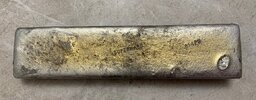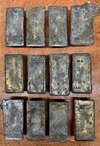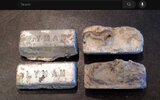gwpercle
Member
Don't panic about the yellow color .
When lead is heated to a too high temp. the surface develops a 'Rainbow" of color on it ... Pure lead will develop the most vivid rainbow colors , other alloy's to lessor extent ...but it's just the heat ...
you will see blue's , red' s and yellow's ... common when "smelting" large batches on a big gas burner ...it gets hot .
The colors can stay for years or fade the dark colors are easiest to see but the yellows appear first , before the blues ... It looks like the ingots were cast in the yellow heat range before the melt got hot enough to make blue colors . Don't worry about yellow color , test hardness and carry on .
Zink contaminated looks like oatmeal ... I don't see that in your ingots . The melt may have gotten a few zinkers but not enough to "contaminate"...your ingots all are smooth and should melt and cast up just fine .
Another thing ...it isn't rocket science ... don't overthink it .
I cast with 50-50 mix of COWW and soft scrap lead that = BHN of 8-9 . That hardness works for all handgun bullets and 30 cal. rifles . Most folks don't realize that Fit of bullet to bore is much more important than hardness . Most folks shoot bullets that are Too Hard .
A undersized hard bullet will lead your bore like all get-out ... get the size right and shoot BHN 8 to 10 and you will do fine .
Gary
When lead is heated to a too high temp. the surface develops a 'Rainbow" of color on it ... Pure lead will develop the most vivid rainbow colors , other alloy's to lessor extent ...but it's just the heat ...
you will see blue's , red' s and yellow's ... common when "smelting" large batches on a big gas burner ...it gets hot .
The colors can stay for years or fade the dark colors are easiest to see but the yellows appear first , before the blues ... It looks like the ingots were cast in the yellow heat range before the melt got hot enough to make blue colors . Don't worry about yellow color , test hardness and carry on .
Zink contaminated looks like oatmeal ... I don't see that in your ingots . The melt may have gotten a few zinkers but not enough to "contaminate"...your ingots all are smooth and should melt and cast up just fine .
Another thing ...it isn't rocket science ... don't overthink it .
I cast with 50-50 mix of COWW and soft scrap lead that = BHN of 8-9 . That hardness works for all handgun bullets and 30 cal. rifles . Most folks don't realize that Fit of bullet to bore is much more important than hardness . Most folks shoot bullets that are Too Hard .
A undersized hard bullet will lead your bore like all get-out ... get the size right and shoot BHN 8 to 10 and you will do fine .
Gary
Last edited:




